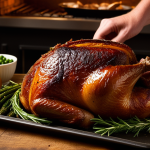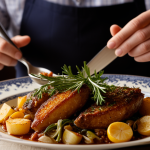Essential Ingredients for an Authentic British Sunday Roast
Understanding the foundation of a traditional Sunday roast is key to capturing its authentic flavors. The core elements start with selecting the right type of meat. Choosing between beef, chicken, lamb, or pork depends on personal taste and occasion. Each offers unique textures and flavors that form the centerpiece of the meal.
Next, fresh vegetables and herbs are crucial. Root vegetables like carrots, parsnips, and potatoes are staples, while fresh herbs such as rosemary, thyme, and sage add depth to the dish. These ingredients amplify the overall taste and aroma.
Also to see : What are the best ways to cook a traditional Sunday roast?
Sourcing quality ingredients is fundamental. Opting for local produce ensures freshness and supports community growers, often resulting in superior flavor and texture. For those without access to local markets, reputable online suppliers can provide high-grade British roast ingredients. Precision in ingredient selection directly affects the roast’s authenticity and enjoyment.
By focusing on these essential British roast ingredients and sourcing tips, home cooks can confidently approach their Sunday roast, ensuring it reflects the traditional qualities so cherished in British culinary culture.
Also to see : How Can You Add a British Twist to Classic Dishes?
Preparing and Seasoning Roast Meats
Mastering meat preparation elevates the traditional Sunday roast to its full glory.
To achieve the perfect British roast seasoning, start with classic blends. Commonly, salt, freshly ground black pepper, and a mix of rosemary and thyme embody the traditional flavors associated with British roast meats. These herbs complement beef, lamb, chicken, or pork without overpowering their natural taste. For added depth, a marinade of garlic, olive oil, lemon juice, and mustard can tenderize and infuse the meat over several hours.
Proper meat preparation begins with bringing the meat to room temperature before cooking. This step ensures even cooking and better texture. Pat the meat dry to encourage browning, which forms the much-desired roast crust. Scoring the fat on cuts like pork and beef helps render it crisply while sealing in juices.
Season generously but wisely to balance flavor without masking the meat’s essence. During roasting, baste meat with pan juices or a simple broth to maintain juiciness. Finally, rest the meat for 15–20 minutes post-cooking; this allows juices to redistribute, resulting in tender, flavourful slices.
Mastering these seasoning techniques guarantees a moist, aromatic centerpiece for your Sunday roast, staying true to British roast traditions.
Signature Sides: Roast Potatoes, Yorkshire Pudding, and More
Traditional Sunday roast sides are just as important as the main meat. Start with roast potatoes, a must-have. Achieving crispy roast potatoes involves parboiling peeled potatoes first to soften the outside. Then, shake them in a colander to roughen their surface — this creates the iconic crispiness. Roast them in hot fat, such as goose or beef drippings, for authentic flavor and texture.
Yorkshire pudding is another classic. Made from a simple batter of eggs, flour, and milk, the secret is a very hot oven and preheated oil or beef drippings in the pan. Pour the batter into the hot fat, and bake until puffed and golden. This results in fluffy yet crispy puddings that complement any meat.
British vegetables, like seasonal greens, carrots, parsnips, and peas, add color and freshness. Cooking these to retain some bite rather than overcooking preserves their flavor and nutrients, enhancing the traditional roast sides experience.
Together, these traditional roast sides complete the plate, balancing textures and flavors while supporting the authenticity of your Sunday roast.
Crafting the Perfect Gravy and Condiments
Creating homemade gravy is essential to elevate a traditional Sunday roast. Start by collecting the pan drippings after roasting; these juices hold intense flavor from the meat and seasonings. To make a rich gravy, deglaze the roasting pan with stock or wine, scraping up browned bits. Simmer this mixture to reduce and concentrate flavors. Thicken with a roux—a blend of flour and fat—or by whisking in cornstarch slurry for a smooth, glossy finish.
Balancing gravy consistency is key: it should coat the back of a spoon without being too runny or thick. Season with salt and pepper, and add a splash of cream or a touch of mustard for complexity.
Traditional British condiments enrich the roast dinner further. Horseradish sauce pairs beautifully with beef, offering a sharp kick. Mint sauce complements lamb with its fresh, tangy notes. Mustard varieties add heat and depth, especially for pork or chicken.
Using these homemade gravies and classic British condiments not only enhances flavors but also upholds the true spirit and richness of the Sunday roast tradition.
Tips for Recreating the Atmosphere and Experience at Home
Creating an authentic Sunday roast experience involves more than the food; ambiance plays a vital role in celebrating British culinary tradition. Start by setting the table with classic British touches: crisp white linens, simple floral arrangements, and genuine crockery evoke warmth and heritage. Proper lighting—soft and inviting—encourages relaxed, leisurely dining.
Sharing the meal family-style reinforces the communal nature of a Sunday roast. Serve platters on the table, allowing guests to help themselves. This fosters conversation and connection, key components of the traditional British dining experience.
To deepen appreciation, incorporate cultural storytelling. Discuss the origins of the Sunday roast, the significance of each component, or family memories associated with the meal. This creates a richer context that enhances enjoyment beyond the palate.
Small efforts—such as playing gentle background music or concluding with traditional British desserts—also contribute. By thoughtfully combining these elements, home cooks can faithfully recreate the welcoming, hearty atmosphere that defines the Sunday roast experience and honors British culinary tradition.
Preparing and Seasoning Roast Meats
Mastering British roast seasoning involves both choosing the right blend of herbs and understanding precise meat preparation steps. Traditional seasoning typically combines salt, freshly ground black pepper, rosemary, and thyme to enhance but not overpower the meat’s natural flavor. For deeper infusion, a marinade with garlic, olive oil, mustard, and lemon juice tenderizes while adding complexity.
Preparing the meat properly is crucial for tenderness. Begin by allowing the meat to reach room temperature, ensuring even cooking. Patting the surface dry encourages a flavorful roast crust through effective browning. For pork or beef, scoring the fat layer helps render it crisply, keeping the meat moist inside.
During roasting, basting periodically with pan juices maintains juiciness, a key marker of quality in a traditional Sunday roast. After cooking, resting the meat allows juices to redistribute evenly, resulting in succulent slices.
Applying these seasoning techniques and preparation tips guarantees a moist, flavorful centerpiece that honors the heritage of the British Sunday roast, satisfying both traditionalists and modern palates alike.



